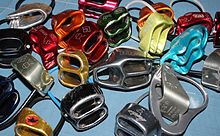Tube (climbing)

The tube or tuber is a tubular abseiling and belay device for climbing . It is a further development of the cutting plate .
Tubes are usually used in sports and indoor climbing to secure companions by means of body security . They have a dynamic braking effect and enable the rope to be released and retrieved quickly. Tubes can be used to secure a climber both in top rope and when leading , but the latter only if the climber cannot fall directly into the lead climbing device in the event of a fall. When using a rope deflection above the belay device, simple tubes can also be used to belay climbers on the subsequent ascent . Devices approved in Europe must comply with the EN 15151-2 standard.
Modern variants with eyelets such as the ATC-Guide also allow the anchor point to be secured by second climbers without redirection. As a further development of the tubes there are self-blocking devices, the so-called "autotubes".
hazards
Belaying with tubes is always dangerous if a fall pull can occur on the belay device , for example if the lead climber falls deeper than the belayer in case of a fall before the first intermediate belay or if the intermediate belayings fail as a result of a fall, i.e. H. beyond the level of the belayer. Securing a second climber without using a reliable rope deflection above the belay device with tubes that are not designed for this is just as dangerous. With these constellations, when the tube is operated, a fall pull and hand brake force act in the same direction, so that the device generates too little braking force to be able to hold a fall. As a result, the climber may fall the entire length of the rope, with an unsecured rope end with a subsequent complete fall.
